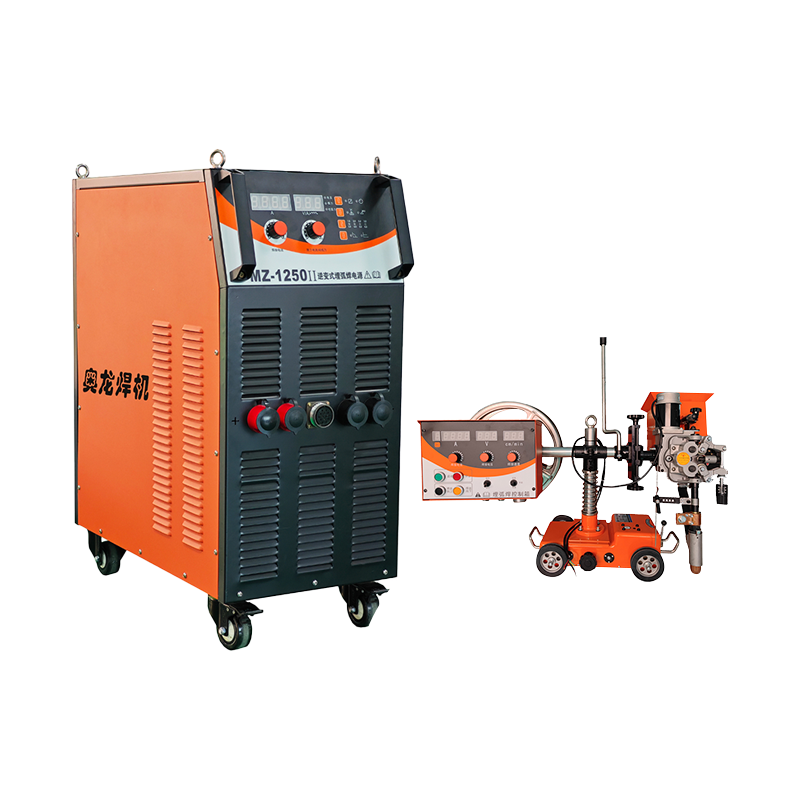The application of Submerged Arc Welding Machine in automated production has greatly improved production efficiency, especially in large-scale manufacturing, heavy industry, and areas requiring high-quality welding (such as shipbuilding, oil pipeline construction, pressure vessels wait). The following is the impact of the application of submerged arc welding machines in automated production on production efficiency:
High welding speed and continuity
Submerged arc welding is a process that enables high-speed, efficient welding. Since the automated welding process can precisely control welding parameters (such as current, voltage, welding speed, etc.), the welding speed is significantly increased. For example, under the right conditions, automated submerged arc welding can achieve welding speeds several times higher than manual welding. In mass production, this efficiency greatly shortens the production cycle and improves the overall production capacity.
Automatic welding: The machine does not need to rest and can work 24 hours a day. It is not limited by the fatigue of the operator like manual welding.
Precise control: Welding speed and arc stability are precisely controlled by an automated system, ensuring efficient and consistent welding quality.
Consistency and quality control
Automated systems can maintain the consistency of welding parameters without being affected by human factors (such as operator skill differences, fatigue, etc.). This enables the quality of each weld to reach the same standard and avoids defects caused by improper operation, such as pores, cracks, lack of fusion, etc.
Stable welding quality: The automation system can continuously control the current, voltage and welding speed, greatly enhancing the stability of the welding process and reducing welding defects.
Reduce rework rate: Due to the high consistency and high quality of automated welding, the probability of product rework is greatly reduced, thus improving production efficiency.
Reduce labor costs
The application of automated submerged arc welding machines greatly reduces reliance on labor, especially highly skilled welding operators. The automated system can easily perform complex welding tasks through program settings, thus saving a lot of human resources.
Low labor intensity: Operators only need to supervise and adjust parameters of the automated welding process, instead of having to perform heavy welding work in person for a long time.
Save training costs: Unlike traditional manual welding, automated welding has lower technical requirements for operators, reducing the cost and time of technical training.
Flexible production scheduling and adaptability
Automated welding systems are usually equipped with highly flexible control platforms that can quickly adjust welding parameters to adapt to different production needs and material types. For diverse production tasks (such as workpieces of different thicknesses and materials), the automated welding system can be quickly adjusted to achieve efficient production conversion.
Quickly switch production tasks: Through preset programs, welding parameters can be quickly switched, reducing downtime and improving the overall flexibility of the production line.
Precise control: For complex welding tasks (such as pipes, long welds, deep welds, etc.), the automation system can precisely control the welding process to ensure accuracy and high efficiency.
Optimization of welding environment
Automated welding systems are usually equipped with automatic wire feeding devices, powder supply systems and temperature control systems to optimize the welding environment and further improve welding efficiency and quality.
Automatic wire feeding and powder system: The automatic wire feeding and powder device can accurately control the wire feeding speed to ensure stability during the welding process and avoid errors during manual operation.
Temperature and atmosphere control: By automatically controlling the temperature and welding atmosphere, overheating or undercooling can be avoided and the stability of welding can be improved.
Save raw materials and energy
Due to the precise control of welding parameters during the automated welding process, material waste during the welding process can be effectively reduced and the full utilization of the welding metal ensured. At the same time, the automation system can accurately control energy consumption and reduce energy waste.
Saving materials: The automated system can accurately control the shape and size of the weld during the welding process, avoiding material waste caused by overfilling.
Efficient energy consumption management: The energy utilization rate during the welding process is high, reducing unnecessary energy consumption.
Improve security
Automated submerged arc welding machines reduce the time that operators are exposed to dangerous environments such as high temperature and high radiation generated during the welding process, and reduce safety risks. In addition, the operational stability of the automation system also reduces accidents caused by human operating errors.
Reduce human-machine contact: Automation equipment can complete work in a safe area, reducing direct contact with operators and ensuring operator safety.
Reduce operational risks: The automated system can continue to work stably and avoid safety accidents caused by manual errors.
The application of automated submerged arc welding machines in production has greatly improved production efficiency, especially in terms of welding speed, consistency, quality control, labor cost reduction, flexibility and safety. Through the automation system, the production line can operate more efficiently and stably, ensuring high-quality welding output, reducing material waste and energy consumption, and promoting the intelligence and modernization of the production process.

Contact Us